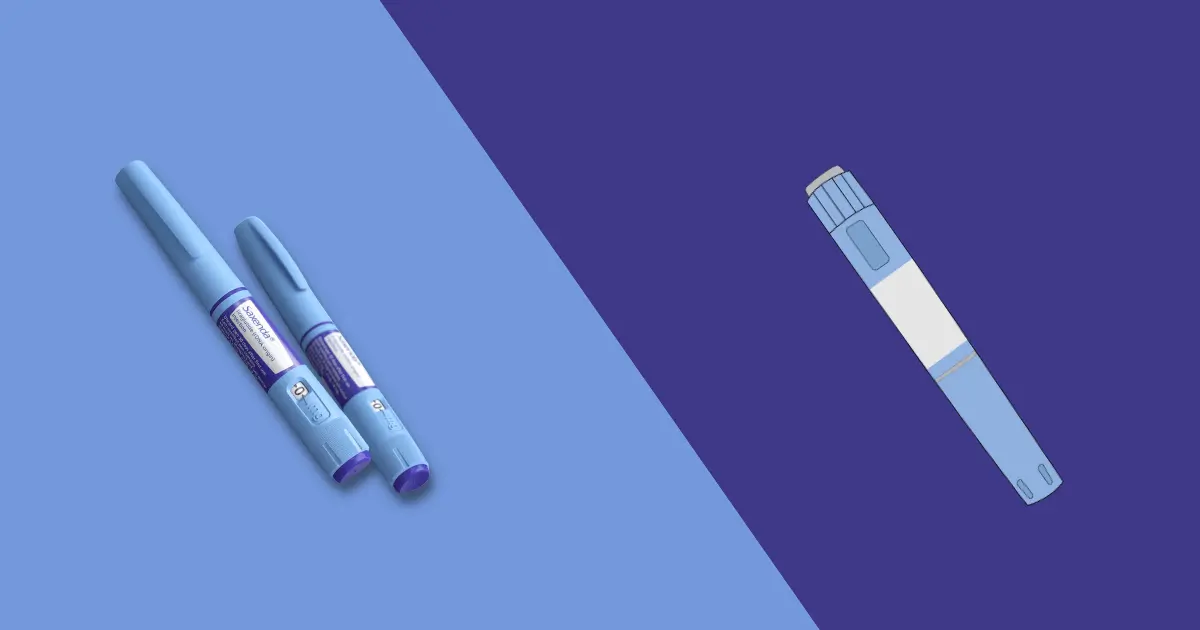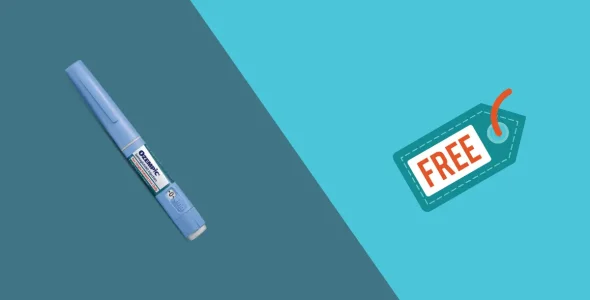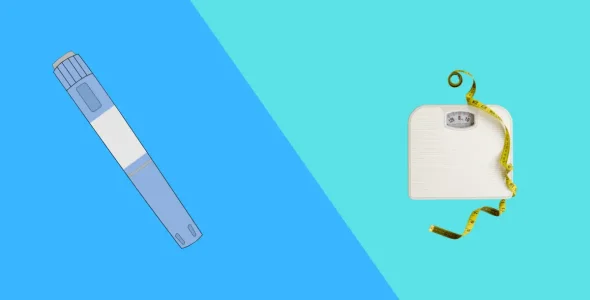Saxenda vs. Ozempic: A head-to-head comparison
Considering Saxenda or Ozempic for weight management? Get the facts to make an informed decision about your health.
Key highlights
- Saxenda and Ozempic are GLP-1 medications with the same mechanism of action but different active ingredients. Saxenda has liraglutide, while Ozempic contains semaglutide.
- Saxenda is FDA-approved for chronic weight management in children aged 12 or more, adolescents, and adults with obesity (BMI 30 or more) and overweight.
- Ozempic is indicated for managing type 2 diabetes and reducing the risk of cardiovascular diseases and worsening kidney disease.
- Ozempic has higher efficacy than Saxenda in weight management and glycemic control. Both medications have similar side effects.
- Insurance plans cover Ozempic for type 2 diabetes but typically do not cover Saxenda and off-label Ozempic for weight loss.
- Consult your healthcare provider to discuss your treatment goals, costs, insurance coverage, and preferences to choose the right medication.
According to the World Obesity Organization, more than one billion people have obesity worldwide, approximately 880 million adults and 159 million adolescents and children. Approximately 3 billion people are overweight. These alarmingly high rates project that obesity and overweight are major health risks. GLP-1 medications play a significant role in managing overweight, obesity and its complications, and type 2 diabetes.
Saxenda (liraglutide) and Ozempic (semaglutide) are two popular GLP-1 receptor agonist prescription medications. Both medications have the same mechanisms of action but are approved by the FDA for different purposes. Ozempic is mainly approved for type 2 diabetes management, whereas Saxenda is indicated for chronic weight management. Ozempic is prescribed off-label for weight management.
This article provides a detailed comparison of Saxenda vs. Ozempic to help you make informed decisions about your treatment options and choose the best medication.
What are Saxenda and Ozempic?
Let’s get into the details of each medication:
Saxenda
Saxenda contains liraglutide, which is a GLP-1 receptor agonist. The active ingredient, liraglutide, mimics the action of a naturally occurring hormone, glucagon-like peptide-1, that regulates appetite and blood sugar levels. The medication occupies GLP-1 receptors in the brain that affect the hunger control center to suppress appetite, delay gastric emptying, and reduce hunger pangs. The medication makes you feel full earlier and for a longer time by promoting a feeling of “satiety”. Reduced food intake helps manage blood glucose levels in type 2 diabetes and promotes weight loss.
Saxenda, a brand name of liraglutide, is approved by the FDA for chronic weight management in children aged 12 or more, adolescents, and adults when combined with lifestyle changes such as increased physical activity, exercise, and a balanced diet. It is indicated for patients with:
- Obesity (body mass index of 30 kg/m² or more)
- Overweight (BMI of 27 kg/m² or more) with at least one medical condition that occurs due to increased body weight, such as high blood pressure, high cholesterol levels, and heart disease.
- Body weight greater than 132 pounds or 60 kgs (in pediatric patients).
Ozempic
Ozempic contains semaglutide, another GLP-1 receptor agonist, that works similarly to liraglutide. Semaglutide has 94% structural similarity to the naturally occurring human glucagon-like peptide-1 hormone. Ozempic works by activating GLP-1 receptors to enhance insulin release, reduce glucose production in the liver (by inhibiting glucagon), and delay stomach emptying. The food moves slowly into the intestines, which makes you feel satiated for a longer time. You do not feel the urge to eat frequently. Reduced food intake lowers blood sugar levels, and the same effect contributes to weight loss.
Initially, the U.S. Food and Drug Administration (FDA) approved Ozempic for managing blood sugar levels in type 2 diabetes patients as an adjunct to exercise and dietary modifications.
Recently, the medication got FDA approval for reducing the risk of worsening kidney disease and cardiovascular deaths in adults with chronic kidney disease and type 2 diabetes, on January 29, 2025.
Additionally, healthcare professionals prescribe Ozempic off-label for weight management. The FDA has not yet approved Ozempic for weight reduction, but the medication has gained significant popularity as a weight loss medication as researchers found that it produced significant weight loss. Semaglutide is also marketed under the brand name Wegovy which is FDA-approved for chronic weight management.
Similarities between Saxenda and Ozempic
Here are a few similarities between Saxenda and Ozempic:
Manufacturer
Both medications are made by the same manufacturer, Novo Nordisk. The company owns the patent for these medications. For this reason, there are currently no generic versions of Ozempic and Saxenda. The generic version of Saxenda is expected to be launched in 2026 or 2027.
Mechanism of action
Both medications work by activating GLP-1 receptors in the body. Activation of GLP-1 receptors leads to appetite suppression, enhanced insulin secretion from beta cells of the pancreas, and reduced glucose production in the liver. These effects lower blood sugar levels and promote weight loss.
Benefits
Ozempic and Saxenda share a few common benefits such as weight reduction, improved blood sugar control in type 2 diabetes and cardiovascular benefits. They reduce the risk of heart disease and improve metabolic profile.
Common side effects
As the mechanism of action of both medications is the same, the side effects of Saxenda are the same as Ozempic. These include nausea, vomiting, stomach pain, abdominal pain, indigestion, diarrhea, excessive burping, and constipation. Severe and rare side effects may include:
- Acute pancreatitis
- Gallbladder disease
- Low blood sugar levels (particularly when used with insulin or sulfonylureas
- Changes in vision (diabetic retinopathy)
- Severe gastrointestinal problems
- Increased risk of aspiration during anesthesia and sedation
- Acute kidney injury
- Suicidal ideation
However, the severity and frequency of side effects may differ. Studies show that gastrointestinal side effects are more common with semaglutide (Ozempic) than with liraglutide (Saxenda). As well, semaglutide may have a greater risk of cholelithiasis than liraglutide.
Both medications are contraindicated for patients with a history of thyroid cancers (such as medullary thyroid carcinoma) and MEN 2 syndrome (Multiple endocrine neoplasia type 2 syndrome), as GLP-1 medications increased the risk of these tumors in rodent studies. Ozempic and Saxenda should not be used during pregnancy and lactation.
If you experience mild side effects with these medications, there is nothing to worry about. They usually subside over time as your body gets used to the medication. If they do not subside or you have severe side effects, consult a doctor before administering the next dosage. In case of hypoglycemia or hypersensitivity reaction, immediately seek emergency care from a nearby healthcare facility.
Saxenda vs. Ozempic: Key differences
These are the key differences between Saxenda and Ozempic:
FDA-approved uses
Saxenda is approved for chronic weight management in adults and adolescents who are obese (BMI 30 kg/m² or more) and overweight (BMI equal to greater than 27 kg/m²) with at least one weight-related health condition problem such as high cholesterol levels, hypertension (high blood pressure), and type 2 diabetes. The medication is also approved for weight management in children aged 12 or more with a body weight above 60 kg or 132 pounds. Saxenda is used along with lifestyle changes including a low-calorie balanced diet, exercise, and increased physical activity.
Ozempic is FDA-approved for improving blood sugar levels in adults with type 2 diabetes, along with a balanced diet and exercise. The FDA has also approved Ozempic for reducing the risk of major cardiovascular events such as heart attack and stroke in adults with type 2 diabetes. Ozempic is also indicated for reducing the risk of worsening kidney disease in adults with chronic kidney disease and type 2 diabetes.
Active ingredient
Both medications contain different active ingredients. Saxenda contains liraglutide, while Ozempic has semaglutide as its active ingredient.
Dosage and frequency of administration
Ozempic is available in 0.25 mg, 0.5 mg, 1 mg and 2 mg doses per injection. The starting dose of Ozempic is 0.25 mg once weekly for the first 4 weeks. Then, the dosage is escalated to 0.5 mg for the next 4 weeks. If tolerated, your healthcare provider increases the dosage to 1 mg once weekly, which is typically the maintenance dosage for Ozmepic. If further glycemic control is needed, the dosage is increased to 2 mg once weekly, which is the maximum dosage.
Saxenda is administered daily under the skin of your abdomen, thighs, and arms.
Saxenda dosage is initiated with 0.6 mg per day in the first week. Its titration schedule is as follows:
- Week 1: 0.6 mg per day
- week 2: 1.2 mg per day
- Week 3: 1.8 mg per day
- Week 4: 2.4 mg per day
- Week 5 and onwards: 3 mg per day
Ozempic is convenient as it is injected once weekly, which is much easier than daily injections of Saxenda.
Effectiveness for weight loss
In various clinical trials, Ozempic outperformed Saxenda for weight management and glycemic control. However, Ozempic shows more serious side effects than Saxenda. If you can’t tolerate the side effects of Ozempic, Saxenda is a better choice.
A SUSTAIN 10 trial enrolled 577 adult patients with type 2 diabetes to compare the effectiveness of a once-weekly injection of semaglutide (1.0 mg) with a daily injection of liraglutide (1.2 mg). The mean weight reduction was 5.8 kg in the semaglutide group and 1.9 kg in the liraglutide group. Semaglutide decreased glycated hemoglobin levels by 1.7% compared to 1.0% with liraglutide. This trial shows that weight loss results and glycemic control with semaglutide are superior to liraglutide.
Another step 8 clinical trial involved 338 obese and overweight patients without type 2 diabetes to compare the effect of weekly subcutaneous semaglutide vs liraglutide (daily). The mean body weight was reduced by 15.8% in the semaglutide group and by 6.4% in the liraglutide group after 68 weeks. The results of this trial demonstrate that semaglutide has significantly greater efficacy than liraglutide when used as an adjunct to a healthy lifestyle, balanced diet, and increased physical activity.
Factors like diet, exercise, body mass index, patient’s tolerance to the medication, comorbid conditions, and compliance may influence individual results.
Cost and insurance coverage
The list price of Saxenda® is $1,349.02 per month. The medication is available at pharmacies for $1,300 to $1,600 or more. In comparison, Ozempic has a list price of $997.58 per 28-day supply. You may get the medication for $1,000-1,300 or more at pharmacies.
Here’s a comparison of the prices for both medications at different pharmacies, as mentioned on GoodRx:
Saxenda vs. Ozempic prices
| Ozempic (28 day supply) | Saxenda (28 day supply) | |
|---|---|---|
| List price | $997.58 | $1,349.00 |
| Walgreens | $995.00 | $1,639.90 |
| Walmart | $995.00 | $1,609.01 |
| CVS Pharmacy | $995.00 | $1,590.40 |
| Costco | $964.99 | $1,616.71 |
Novo Nordisk offers the Ozempic savings card and the Saxenda savings card to commercially insured patients with coverage for the medication.
The Ozempic saving card can save $100 off a 1-month prescription of Ozempic, $200 on a 2-month prescription, and $300 on a 3-month prescription. Eligible candidates can get a 1, 2, or 3-month supply of Ozempic for as little as $25.
If eligible, you can also get free Ozempic or Rybelsus through the Novo Nordisk patient assistance program.
With the Saxenda savings card, eligible patients can get the medication for $30 or less per month. You can check the eligibility criteria at Novo Nordisk’s official website.
Additionally, a generic version of Saxenda is expected to be available in the market by 2026 or 2027, which will lower the cost of medication significantly.
Insurance companies typically do not cover weight loss medications such as Saxenda. Ozempic for type 2 diabetes is covered by most insurance plans. Getting insurance coverage for Ozempic is much easier than for Saxenda. However, if you use Ozempic for weight loss, insurance will typically not cover it.
Saxenda vs. Ozempic: Safety profile
A systematic review compared the effectiveness and safety profiles of semaglutide (Ozempic) and liraglutide (Saxenda). Semaglutide 2.4 mg once weekly showed the highest efficacy compared to lower dosages of semaglutide and liraglutide, but had the highest risk of side effects. 3 mg liraglutide was less effective than semaglutide, but still had its own set of serious side effects.
In terms of safety, semaglutide 2.4 mg showed the most adverse events, followed by liraglutide 3.0 mg, liraglutide 1.8 mg, and semaglutide 1.0 mg. Serious adverse events were common with liraglutide 3.0 mg. As for hypoglycemia, semaglutide 2.4 mg had the highest rate.
However, Ozempic offers greater cardiovascular benefits and metabolic improvements than Saxenda.
Both Ozempic and Saxenda are FDA-approved medications and safe for patients when used for FDA-approved indications. Consult your healthcare professional to weigh the pros and cons of these medications and choose what’s best for you!
Saxenda vs. Ozempic: Key differences
| Saxenda | Ozempic | |
|---|---|---|
| FDA-Approved Uses | Chronic weight management for adults and adolescents with obesity (BMI ≥30) or overweight (BMI ≥27) with at least one weight-related health condition; also approved for weight management in children aged 12+ | Improves blood sugar levels in adults with type 2 diabetes; reduces the risk of cardiovascular events (heart attack, stroke) in adults with type 2 diabetes; reduces risk of worsening kidney disease in adults with type 2 diabetes |
| Active Ingredient | Liraglutide | Semaglutide |
| Dosage and Administration | Injectable, daily administration: 0.6 mg to 3.0 mg | Injectable, weekly administration: 0.25 mg to 2 mg |
| Starting Dose | 0.6 mg per day, titrated up to 3 mg per day | 0.25 mg once a week, increased gradually to 1 mg (maintenance), and 2 mg (maximum dosage) |
| Effectiveness for Weight Loss | 6.4% weight loss in trials | 15.8% weight loss in trials (SUSTAIN 10 study) |
| Glycemic control | Lowers glycated hemoglobin, but not as efficiently as Ozempic does | Lowers glycated hemoglobin levels significantly , has cardiovascular and metabolic benefits |
| List price | $1,349.02 per month | $997.58 per 28-day supply |
| Insurance coverage | May not be covered by insurance coverage | Usually covered by insurance for type 2 diabetes |
| Insurance Savings | Savings card can reduce cost to $30/month | Savings card can reduce cost to $25/month for 1-3 months supply |
| Safety Profile | Risk of serious side effects; more adverse events with higher doses | Higher risk of side effects (hypoglycemia); more cardiovascular benefits |
| Generic Availability | Expected by 2026-2027 | Not available at this time |
| FDA-Approved for Children | Yes, for children aged 12+ with weight-related health conditions | No, only for adults with type 2 diabetes |
Choosing between Saxenda and Ozempic
Consider these factors when choosing between Saxenda and Ozempic:
Weight loss as the primary goal
If weight loss is the primary goal, Saxenda is specifically approved by the FDA for chronic weight management. If enhanced weight loss is needed, consider switching to Wegovy which contains the same active ingredient as Ozempic, semaglutide.
Diabetes management
If your primary goal is to manage type 2 diabetes and reduce cardiovascular risk, Ozempic is a better option as the medication is approved for type 2 diabetes and cardiovascular risk reduction. If enhanced blood sugar control is needed, consider switching to Mounjaro (tirzepatide).
Individualized treatment
If you have a history of cardiovascular disease, such as heart disease, stroke, myocardial infarction, and chronic kidney disease, Ozempic is a better choice. Discuss your goals, needs, and medical history with a healthcare professional to determine the best choice.
Other factors to consider
Consider the following factors when choosing the best medication:
- Discuss your treatment goals, such as weight loss, diabetes management needs, or both, with your healthcare provider. They will recommend the best medication according to your treatment goals.
- Inform your healthcare provider about your previous medical history, treatments you have taken, comorbid conditions, and which medications you are currently using so they can help you choose a suitable medication.
- If you prefer a daily injection, Saxenda is better as it is administered daily. In comparison, Ozempic is administered only once a week.
- Most insurance companies do not cover Saxenda for weight loss. However, Ozempic is generally covered by insurance plans for type 2 diabetes.
- Ozempic may have a slightly higher risk of gastrointestinal side effects than Saxenda. If you can not tolerate one medication, you can switch to another one.
Who should use Saxenda?
Ideal candidates for Saxenda are those who are non-diabetic and aim to use the medication for weight loss only. These include:
- Obese patients (BMI 30 or more)
- Overweight patients (BMI 27 or more) with at least one weight-related health condition, such as high cholesterol levels, heart disease, high blood pressure
- Pediatric patients aged 12 or more and adolescents with a BMI of 30 or higher or with a body weight of 60 kg (132 pounds).
- Those who prefer daily injections instead of weekly injections.
- Do not use Saxenda if you have any allergies to liraglutide or any of the medication’s ingredients.
The generic version of Saxenda is expected to be available on the market very soon. It will be much cheaper than the brand name Saxenda.
Who should use Ozempic?
Patients with type 2 diabetes, or those who are at risk of developing cardiovascular disease or have an existing cardiovascular disease or chronic kidney disease, who prefer weekly injections over daily injections are the ideal candidates for Ozempic.
The medication is prescribed off-label for weight management in obese and overweight patients with at least one weight-related health condition. It is important to keep in mind that insurance plans typically cover Ozempic for type 2 diabetes only and not for its off-label usage.
Frequently asked questions
Is Ozempic better for weight loss than Saxenda?
Yes, Ozempic shows greater weight reduction than Saxenda, but it is not approved by the FDA for chronic weight management. In the STEP 8 clinical trials, Ozempic showed a weight reduction of 15.8% of the starting body weight. In comparison, Saxenda reduced body weight by 6.4%. Ozempic is used off-label for weight management, but Saxenda is FDA-approved for this indication.
Which medication has fewer side effects, Saxenda or Ozempic?
Common side effects of both medications are the same. However, a systematic review comparing both medications shows that 3 mg liraglutide (the maximum dose of Saxenda) had greater side effects than 1 mg semaglutide (the maintenance dose of Ozempic). Another study shows that Ozempic users may have a higher risk of gastrointestinal side effects and pancreatitis.
Can I use both medications together?
No, you cannot use Saxenda and Ozempic together.
Are there any long-term risks?
Long-term risks of these GLP-1 medications are rare, but they exist. These include gastrointestinal problems, stomach ache, gallbladder issues, pancreatitis, injection site reactions, personality changes, mood and behavioural changes, suicidal ideation, kidney problems, and changes in vision (due to diabetic retinopathy). Ozempic is known for a side effect referred to as “Ozempic personality”.
Can I switch from Saxenda to Ozempic (or vice versa)?
Yes, you can switch from Saxenda to Ozempic or vice versa, but you can not switch directly, as both medications have different dosages. Consult your doctor before switching medications. They will adjust your dosage and create a customized treatment plan according to your current dosage regimen. Do not change any medication without seeking medical advice.
How long does it take to see results with Saxenda vs. Ozempic?
You may see some weight loss within 2-4 weeks of using Saxenda. However, maximum results may be seen 6 months after starting the medication. In comparison, Ozempic usually takes 1-4 weeks to show results. You may see significant changes in body weight after one month. These changes are more obvious with higher doses.
Bottom line
Saxenda is approved for chronic weight management in pediatric patients aged 12 or more, adolescents, and adults with obesity (BMI of 30 or more) or overweight with at least one weight-related health condition. Ozempic is indicated for managing type 2 diabetes and reducing the risk of cardiovascular events and worsening kidney disease.
Although both are GLP-1 medications, their dosage frequency is different. Saxenda is injected daily, while Ozempic is administered once weekly. Both medications are expensive without insurance. Insurance plans generally cover Ozempic for type 2 diabetes but do not cover Saxenda or Ozempic (off-label) for weight loss (off-label). However, Ozempic and Saxenda savings cards reduce the prices significantly for eligible patients.
Clinical studies have shown that participants taking semaglutide (Ozempic and Wegovy) experienced more significant weight loss than those taking Saxenda.
Consult your doctor to discuss your treatment goals, concerns about the costs and insurance coverage, and your personal preferences. They will help you choose the right medication.







